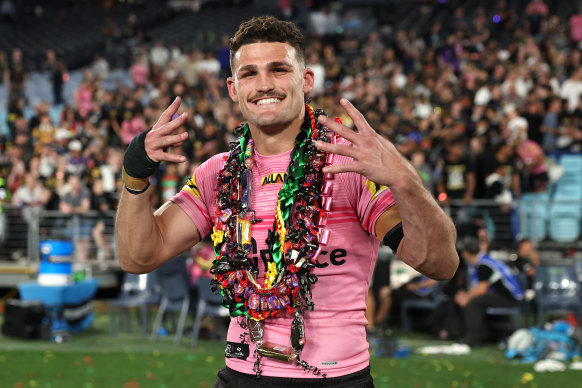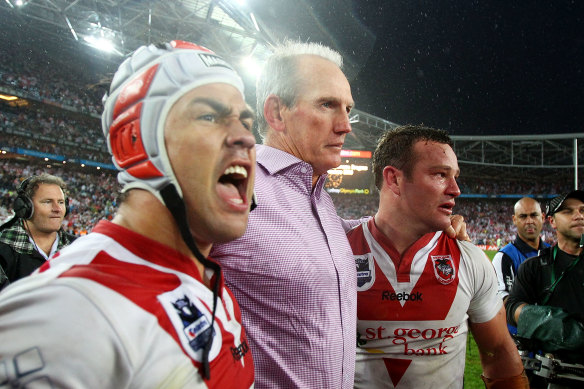By Cindy Yin
Four hundred milliseconds – the blink of an eye. That’s how quickly Panthers halfback Nathan Cleary can decide what his next playing move will be.
To him, the fraction of a second decision is so fast it feels subconscious. If you put a regular person on the field in the Penrith No.7 jersey, it would take them at least 1000 milliseconds to do the same.
In the context of a rugby league match, that’s the difference between making a genius play or being called a Muppet on social media.
Recently crowned four-time premiership winner Cleary could be the poster boy of football smarts, debunking longstanding views that rugby league players are all brawn and no brains.
“I would love to have Nathan Cleary doing a neuropsychological assessment with me because he is one of the smartest players that I’ve ever seen,” Dr Alberto Filgueiras, sport and exercise psychology researcher at Central Queensland University, said.
It’s not just Cleary leading the pack – halfbacks in general undertake key strategic roles and are largely responsible for making plays and directing the team’s attack.

Nathan Cleary celebrates after winning the Grand Final match between the Melbourne Storm and the Penrith Panthers on October 6.Credit: Getty Images
“Halfbacks can see things that most players can’t, which means that probably they can see things that most of us, normal human beings can’t,” Filgueiras said.
The unpredictability of the game means players need to make snap decisions and adapt quickly to unknown situations. Players such as Cleary adjust strategies as they go based on where the ball or their opponents will be. This means in fast-paced games, a player’s cognitive skills, or ‘executive functions’ allow them to juggle multiple things at once and demonstrate a considerable level of intelligence.
Findings from Filgueiras’ 2018 study show athletes use areas of the brain involved in attention, memory, and motor control more than previously thought. “Every sport where you have balls, and you have opponents or adversaries, requires a higher level of executive functions to make decisions,” he said.
Repetitive movements practised in training can further boost players’ decision-making skills because it becomes ingrained in them – so much so that game day decisions might feel like an instinct or gut feeling.
“They tend to make these decisions based on their feelings, they’re going to call it instincts or guts, right? They might say that, but the fact is, it is because they do train a lot, they have these skills, and these better skills lead to better decision-making,” Filgueiras said.
Jamie Soward, former NRLW coach and retired halfback who won the 2010 premiership with the Dragons, agrees.

Jamie Soward, Wayne Bennett and Dean Young of the Dragons celebrate after their win in the 2010 Grand Final match against the RoostersCredit: Mark Nolan
“The easiest part is trusting your first instinct,” Soward said. “It’s so systematic. ‘If we get to here, we’re gonna do this, and we’re gonna do that’ … you’ve done hours and hours and hours of kicking and passing, and kicking and passing.”
“You’re not only playing footy, you’re living and breathing it. I think people underestimate the smarts that it takes to play footy.”
Football players are also highly skilled in spatial memory and spatial perception. These markers of intelligence allow them to grasp spatial information and subconsciously make conclusions about the best possible outcome.
They can see spaces most of us cannot, can process wide peripheral views, and can observe objects outside their direct focus of attention.
Filgueiras said players not only have an ability to “perceive more space than most of us,” but they can also “make calculations on the most likely spaces, and consider the movement of the opposite defensive line, which is extremely complex.”
It’s hard-earned skills like these which are critical for anticipating opponents’ future movements, according to Filgueiras.
“So not only do they have better spatial perception, but they also can see the future,” he said.
Players such as Cleary, Andrew Johns, and Cameron Smith are among the greatest in rugby league because of their remarkable ability to see the game a few steps ahead and strategise, said Soward.
“That’s years and years of footy and honing your craft… Those guys are so instinctive but also understand and see the game a different way. I think that’s what separates the greats from other players in the NRL.”
Sports news, results and expert commentary. Sign up for our Sport newsletter.